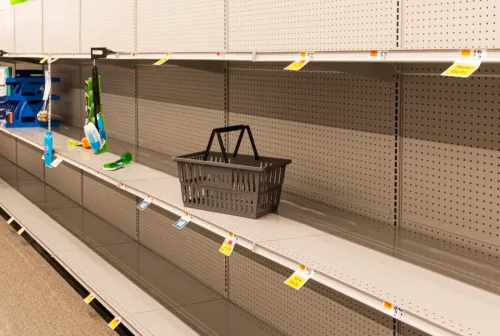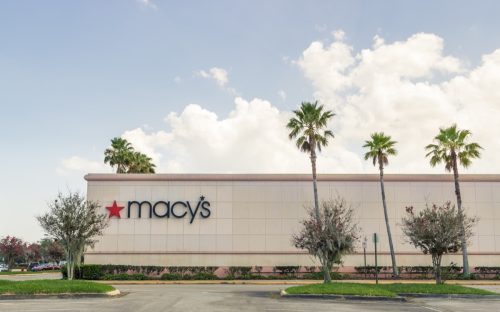Kohl's and Gap Are Both Pulling These Items From Shelves
The popular clothing chains are making some adjustments to their merchandise.

We've all gone back to a store to buy something we saw just days before only to find it conspicuously missing. This could be because it's already out-of-stock—something customers learned to accept thanks to supply chain issues and subsequent shortages brought on by the pandemic. Or maybe the product you're looking for is simply somewhere else in the store, as larger retailers often rearrange merchandise to keep their stores feeling fresh. But sometimes the product has been taken off of the shelves altogether, and now two of the most popular clothing chains announced that they'll be doing some serious editing. Kohl's and Gap just shared that certain items are getting pulled soon. Read on to find out which merchandise is being removed.
READ THIS NEXT: If You Shop at Kohl's, Prepare for This "Efficient" Change at All 1,100 Stores.
Retailers are regularly pulling products from shelves for different reasons.

Companies will remove items from stores for a number of reasons, including consumer pressure and safety concerns. Back in May, Walmart pulled a newly introduced Great Value-branded ice cream made in recognition of Juneteenth after the retailer was accused of ripping off a Black-owned ice cream company and capitalizing off of the holiday.
In June, Marshalls and T.J. Maxx were among the retailers who removed nest swing egg chairs from their stores because of a recall that was initiated following 19 reports of injuries ranging from "cuts, scrapes, [and] soreness" to one account of broken ribs and a collapsed lung.
Now, Kohl's and Gap are pulling certain products from shelves—but thankfully it's not because of customer backlash or a recall.
Kohl's and Gap are now removing merchandise from stores.

Kohl's and Gap are getting ready to pack away some products, CNN reports. The two popular retailers have confirmed that they will start pulling unsold merchandise off of shelves to hold in warehouses. The clothing chains will then put these products back on shelves later this year and in 2023—a strategy commonly known as "pack and hold," per CNN.
"We're confident that we will be able to integrate our pack and hold inventory with future assortments," Katrina O'Connell, Gap's finance chief, said during an Aug. 25 earnings call. According to O'Connell, the chain will put unsold basic shorts, short sleeve tees, and tanks in storage to sell again later.
During an Aug. 18 earning call, Kohl's CFO Jill Timm said the company is holding onto an extra $82 million worth of inventory that includes sleepwear and fleece. According to Timm, Kohl's will start selling this unsold merchandise again ahead of the holiday season. "We have taken action to address inventory," the CFO said.
RELATED: For more up-to-date information, sign up for our daily newsletter.
Both retailers are dealing with excess inventory.

Gap's inventory for the last quarter was 37 higher than what it was last year, according to O'Connell. Kohl's inventory, on the other hand, increased by 48 percent, Timm said. According to The New York Times, many retailers are getting stuck with more unsold inventory now as consumers are cutting down on their spending because of high inflation. The U.S. Bureau of Labor Statistics (BLS) reported in June that the nation's annual inflation rate had hit a 40-year-high of 9.1 percent.
"It's unprecedented," Chuck Johnston, a chief strategy officer at goTRG, told the newspaper. "I have never seen the pressure in terms of excess inventory as I am seeing right now."
Other companies have announced different strategies to deal with inventory issues.

Other major retailers such as Walmart, Macy's, Nordstrom, and Target have also recently confirmed that they are dealing with concerning levels of excess inventory. But many of these retailers have decided to implement more discounts and mark down merchandise to try to fix overstock problems. The New York Times reported that Macy's, for instance, is focusing specifically on discounting "pandemic-related" categories, such as activewear, sleepwear, and home goods, as well as lowering prices on private-brand merchandise and seasonal goods.
"We're responding to make sure that our customers are getting the fair value, and we're liquidating the inventory that needs to be out by a certain date," Macy's CEO Jeff Gennette explained to the newspaper.
Both strategies have their pros and cons, experts say. Discounts can "dilute a brand's image," according to CNN. In other words, "promoting can be cheap today and very expensive tomorrow," Simeon Siegel, an analyst at BMO Capital Markets, told the news outlet.
On the other hand, holding unsold merchandise can allow retailers to sell these items at high prices when consumer demand strengthens. But it's also expensive to hold excess merchandise in warehouses, and there's always the risk that older items won't sell in future seasons. "A retailer doesn't want to tie up their inventory dollars in products that aren't moving," Siegel noted.





















